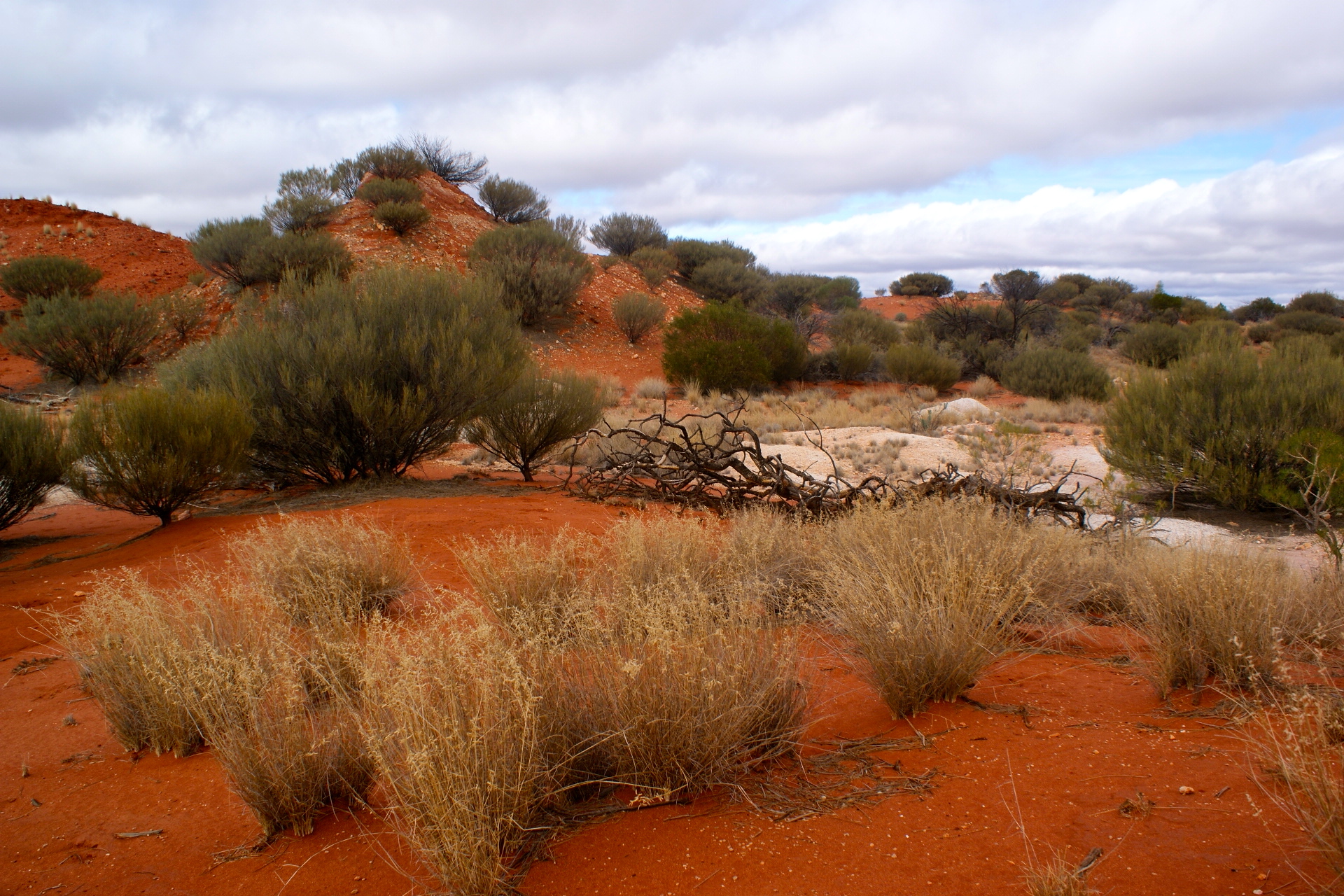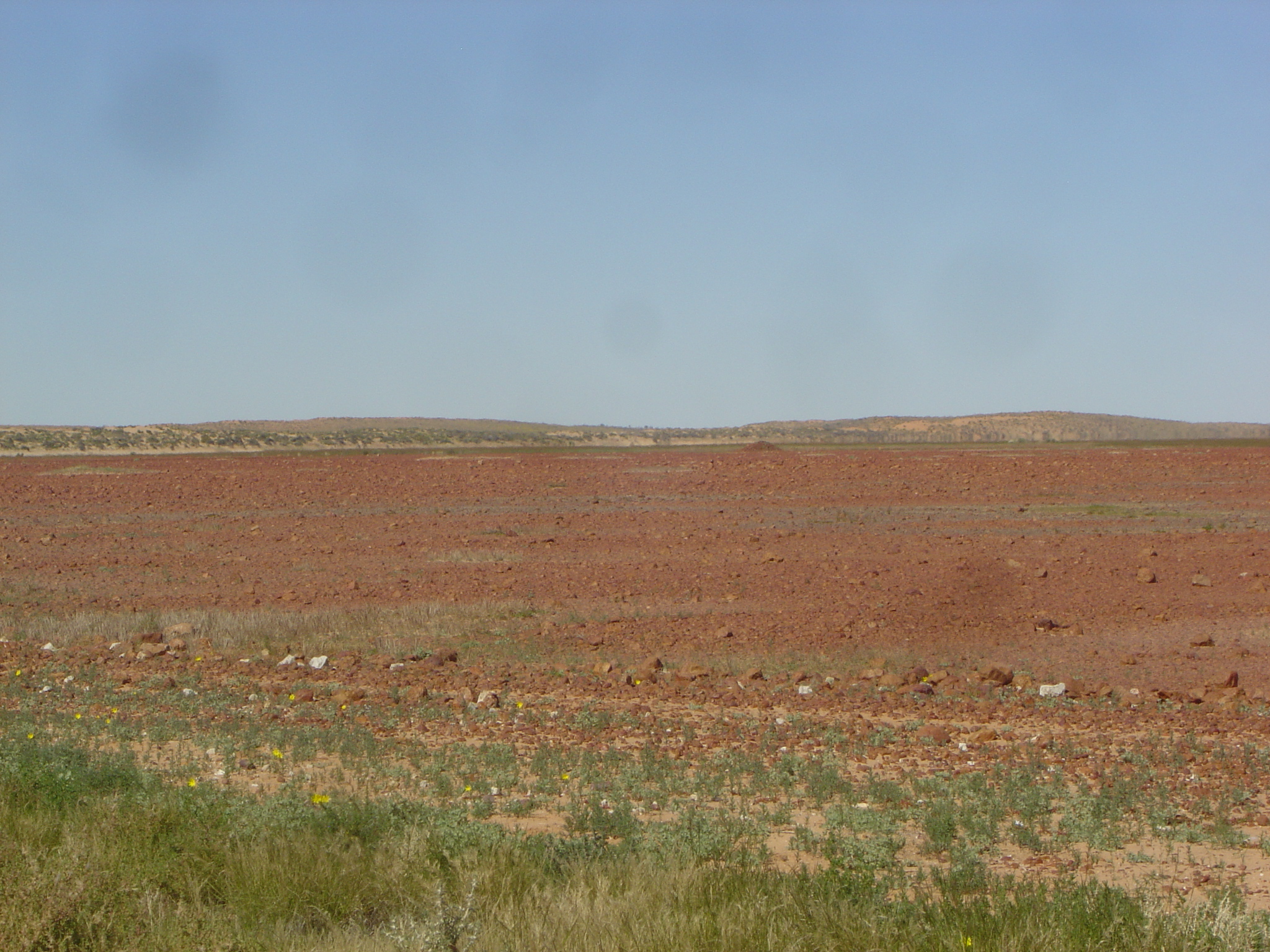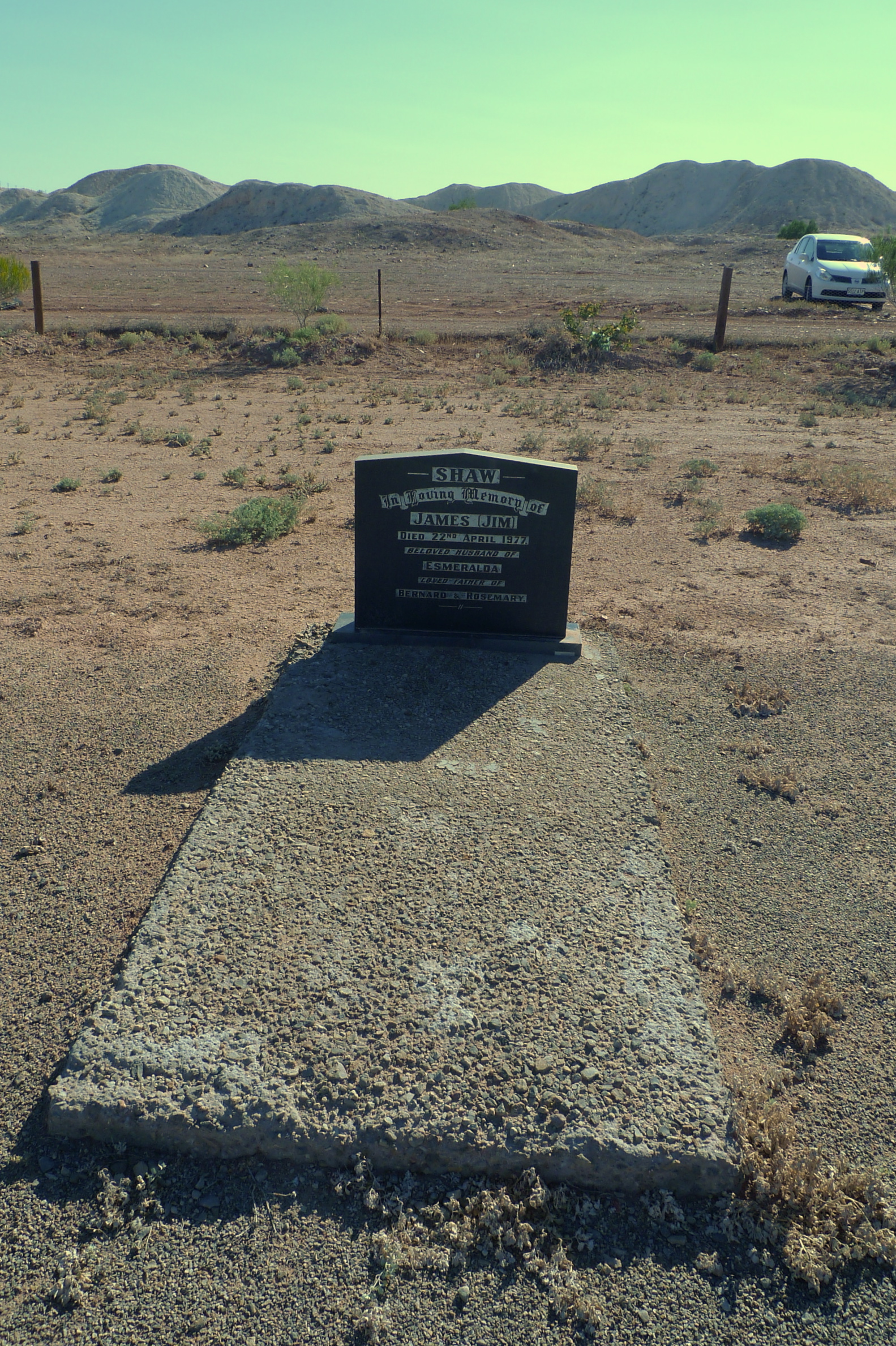Coober Pedy and Andamooka Opal Fields - Iron Man Jim Shaw
1 November 2013 by Johno
Categories: Opal Fields Characters | Opal Fields History | Australian Opal
Iron Man Jim Shaw
In the history of the opal fields there are always some very eccentric people who pop up. You probably had to be a bit different to head off into the desert to toil in extremely hot and uncomfortable conditions to dig for opal, especially in the early days of opal mining. There were very few amenities and even basics like food and water were very hard to come by. Despite all this, many men and even a few women, were enticed to dig for that elusive gem, the opal. The following is the story of one of those characters who arrived at Coober Pedy and later went on to Andamooka and has left a legacy because of his unusual antics. His name was Jim Shaw and he is still referred to as the "Iron Man". I have obtained most of the information about Jim from the book "Opal Men" by P Vin Wake. This is a great read if you can get a copy of it,as it tells stories of some of the more unusual characters who arrived and worked on the opal fields of Australia.
Iron Man's Arrival
It was February 1920 when Jim stepped off the train at Tarcoola in South Australia. He had travelled by train from Western Australia and was headed for Coober Pedy. He was a heavyset man, over six feet in height and had a rugged appearance.
Upon arriving at Tarcoola he asked how a man could get to Coober Pedy from there. He was told that most people waited for the station truck and paid for a ride on it to the opal field. He was also told it had left yesterday and wouldn't be back for a while, so he would have to wait. This did not suit Jim and so he decided he would walk there pushing all his goods in his iron wheeled wheelbarrow. This was apparently a common form of transport for miners in those days. There are many tales of gold miners setting out for Kalgoorlie pushing their barrows. There are also many tales of them dying on the way too. Anyway, Jim decided he would push his barrow the 150 miles to Coober Pedy across sand and gibber plain desert.
The following photographs show what some of the country would have looked like.


Jim would have to push his barrow across endless sand-hills and gibber desert in temperatures over 30 degrees centigrade during the day and approaching freezing at night. Naturally the locals at Tarcoola tried to talk him out of it but Jim was adamant. He had pushed this same barrow across a lot of desert in Western Australia and he was sure he could do it to Coober Pedy.
Before he started he also gave a show to the locals in the pub. He was referred to as the "Human Buck Jumper" and claimed he could buck off anyone sitting on his back as long as they were under 10 stone. (140 pound) One of the locals, who happened to be a horse breaker, quickly took him up on a bet of one pound and Jim sank to his knees and the young local jumped on his back. Jim bucked and jumped about and the young lad reckoned his bet was won when all of a sudden he was sent flying. Jim had lived up to his reputation and was another pound richer. Jim asked if there were any other takers but no-one came forward so he went off to buy some food for his trip.
His barrow was well made with a wide steel rim to help over the sand country. He also had a good load of mining equipment as well as a blanket roll and a small tent. He also carried food and about 5 litres of water so the barrow would have weighed a lot. I doubt I could have even moved it let alone push it over sand-hills.
Jim set off late in the afternoon and with only a few rests pushed his barrow until midnight before stopping to sleep. Rugged up in his blanket he settled down and slept well. The next morning, before sun up, he cooked a hearty breakfast of eggs and bacon and set off again. As soon as the sun rose the little black flies which infest the desert country, attacked him. They are remorseful and get into your eyes and mouth and make any travel very tiring.
A while later he arrived at his first sand-hill and quickly decided he could neither push, nor pull, his loaded barrow up these sand-hills. His only solution was to carry all of his equipment and food up the hill in a number of trips, then pull the empty barrow and reload it at the top for the downhill trip. This was going to slow him down enormously as well as require a lot of energy. He was starting to have some doubts as there were many more sand-hill to come but he continued on. Pride more than anything would not have allowed him to give in. He was "the Iron Man".
After several more sand-hills he arrived at the hut of a boundary rider. This was a man whose job it was to ride along the boundary fences of the large cattle station and repair any fences It was a lonely job so he was glad to see Jim when he arrived. When Jim explained what he was doing the man was incredulous. He couldn't believe anyone was silly enough to tackle a feat like this. Jim shared his meal with him and after a while headed off again with the boundary rider saying what he been through was the easiest part of the trip. "Wait until you see what is ahead." The gibber desert would be the real test for Jim and his barrow. Jim walked again until it was quite late and then rested again.
The next day he was up before dawn and after massaging his aching legs he was off again. he had only 10 miles to go to the Bulgannia Station and was looking forward to a bit of a rest. It was not to be an easy 10 miles. A strong northerly blew up and he had to cross a long stretch of loose sand. It was also very hot and he was losing a lot of moisture from sweating. And his water supply was running low. Many times he had to carry his gear across the sand dunes and go back for his barrow and this was becoming very tiresome. A while later, completely exhausted he arrived at Bulgannia Station homestead. The manager of the station could not believe his eyes and quickly gave Jim some water to douse himself with.
Refreshed from his overnight stay at the homestead he headed off the next day.. The track was now a bit better and a cool change had arrived making conditions a little better. But the flies were worse than ever.
He arrived at McDoull Peak homestead and was also treated hospitably.
At Ingomar Station the manager tried to dissuade him from continuing as he still had 50 miles to go and as it was in summer it was madness for him to continue. Jim asked could he stay for a few days and have some leather to resole his shoes as they were just about worn out from the sand and gibbers. There were also long stretches with no water on the next stage but Jim would not be deterred.
He set from Ingomar late in the afternoon and walked again until late at night. He was even beginning to doubt that the chance of finding opal was worth what he was putting himself through. He slept late and was in a bad mood for oversleeping. This mood was worsened when he saw the sand-hills looming up before him again. He was now back to the backbreaking effort of carrying his gear to the top of the sand-hills and going back to fetch the barrow. It was getting hotter and hotter as the north wind blew. He was carrying extra water for this stage after leaving Ingomar Station but was having to drink more because of the heat and the exertion.
At last he was over the sand-hills, but things did not get any easier. He was now in gibber country. The entire surface was covered in rounded, brown gibber stones and these are agony to walk over let alone push a barrow over. He persevered and the barrow was pushed and bounced over the rough surface. Two hours after dark he stopped to rest and cleared away a small area to lay down. Everything was deathly quiet. Not a sound. There was not even the sound of the wind as there were no trees anywhere around.
The next morning he was dismayed to see that the wheel of his barrow was buckling due the very rough ground conditions. His feet were also very sore from walking on the gibbers. He was still 30 miles from Coober Pedy.
He kept on going
Late the next day the wind dropped. He was almost out of water and looking ahead for signs of a waterhole he had been told about near the 17 mile opal field. He saw trees in the distance and was greatly comforted but when he looked behind him he saw a red-brown wall towering into the sky and approaching at great speed. It was a huge dust storm. He broke into run. He ran almost blindly because of the dust and only stopped when he ran into the fork of a tree and was abruptly stopped. He fell to the ground exhausted but happy as he heard the sound of galahs above the wind. They would only be there if there was water around.
Then it rained and he was soon soaking wet and cold but it was worth it. The squall soon ended and Jim looked around and found a large pool in the bed of the creek. He washed himself and his clothes and thoroughly enjoyed his first dip for ages.
The next morning he set off in good spirits and was met on the track by Charlie Sharpe with a string of camels. Charlie offered to let Jim put his gear on the camels but Jim would not hear of it.
According to P Vin Wake, Jim said, " Thanks mate, but that would never do. Y'see, I laid bets at Tarcoola that I'd make the field under me own steam - and if you carried anything now it might give those mugs a chance to back down. I want to collect that money off them."
In the middle of the following afternoon Jim arrived at the Five Mile field in newly washed clothes and was greeted by many of the miners who were waiting for him. They said he looked like he had only come from over the hill. There was quite a reception for him and the grog flowed. He was challenged in buck jumping again and also in "pulling on a stick" This is where both men sit down with their feet touching and hold onto the end of a stick. They then start pulling and the man who unseats the other is the winner. Needless to say Jim won and pocketed a considerable sum as bets were placed on each contest.
Jim settled in Coober Pedy and learnt the art of opal gouging. He worked several claims but never found much. When his money went and no-one would accept bets for buck-jumping, he took on well sinking and fencing to make a living.
Eventually he moved to Andamooka in semi retirement but doing a bit of mining as well. His favourite possession was a medal which had been given to him years ago. On it was inscribed "The Champion Human Buck-jumper".
Jim died at Andamooka in 1977 and is buried in the cemetry. A photograph of his tombstone is shown below.

That is part of the story of "Iron Man Jim Shaw". Truly a legend of the opal fields.
In 2016 I received an email from Andy Anderson who relates a couple of true tales about Jim Shaw. I quote" He had started to go bald and one of his mates said to rub his thinning top with metho and to light it, well this works in the bush. Burning off brings in new growth. So Jim tried it. It is said that he had a burnt scalp for a few days then miraculously new fuzz!" The second tale goes as follows, Jim Shaw was known as the human buck-jumper as explained earlier in this post. "One night a ringer thought he was smart and put a pair of spurs on and tried to ride Jim. When he was bucked off and as they both got up Jim gave him an almighty punch which floored the ringer, and he said you should never use spurs on a horse. He thought they were very cruel."
What great yarns. Thank you Andy.
It is now 2017 and Andy has sent a few photographs which I will now share. The first is a photograph of Jim's hut at Andamooka as it is now.
Just click on the underscored jimshaw1 to see the picture.
The next photograph is of an inscription on the shed which said "Jim Shaw 1956" but is now very faded.
The final photograph is of the inside of Jim Shaw's hut as it is now. Peter Webb advises that Jim never actually owned the hut but had permission to live in it for as long as he lived. Thank you Peter.
Thanks Andy for the photographs.
It is 2018 and Andy has written to let me know a few more things about Jim.
Apparently Jim had a face like leather and used to burn off his whiskers with a twisted up newspaper. Andy's friend had actually seen him do it. His friend had also seen him do the broomstick pull with two blokes on the other end of the broomstick. Jim won. He was certainly a very strong man.
Thanks Andy for that.
Johno